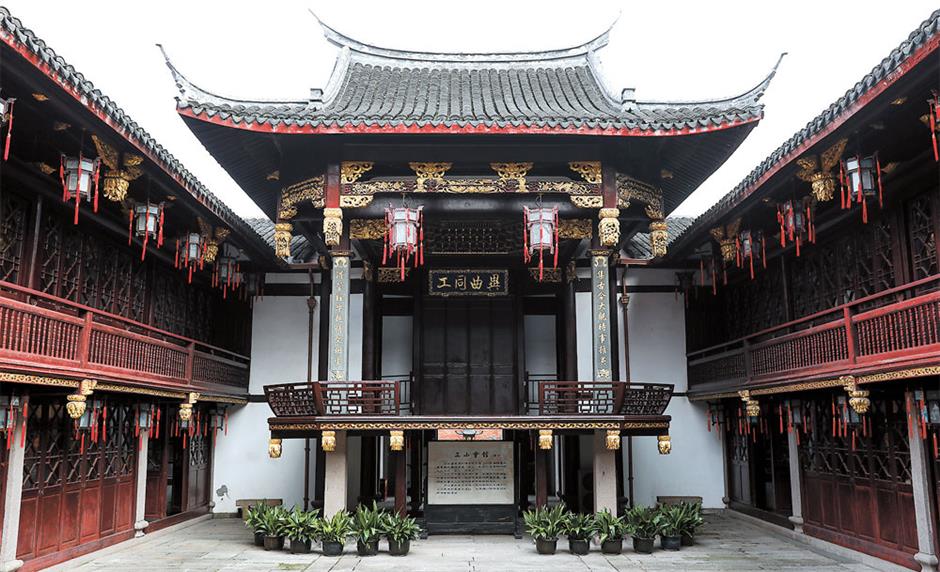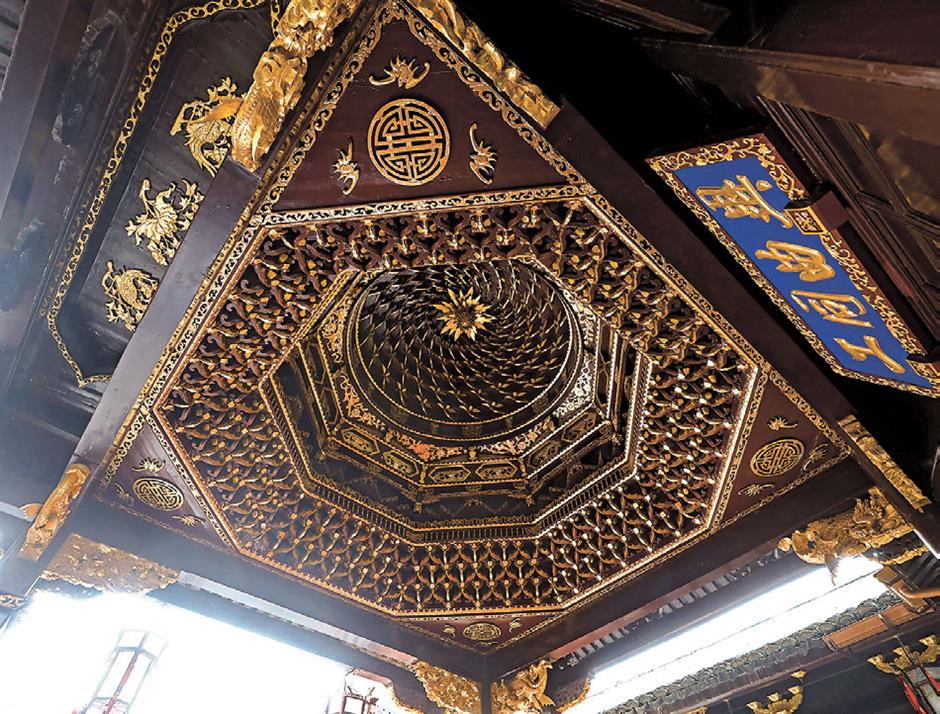
Sanshan Guild Hall contains Shanghai’s only opera stage with preserved original carvings.
Sanshan Guild Hall, named for three Chinese mountains, was built in 1909 as a meeting place for fruit industry businessmen. It is the only well-preserved building of its kind from the Qing Dynasty (1644-1911) in Shanghai.
Today it’s a historical museum.
The hall was built by businessmen from Fuzhou, capital of southeast China’s Fujian Province. Its architecture is a rare combination of traditional Fujian style and Shanghai decor. The main body covers 1,000 square meters with carved beams and painted pillars.
“The main columns of the hall are made with stone, which is typical of Fujian,” said Ban Xianfu, former curator of the hall who retired this year but maintains an association with the site. “The climate in Fujian is wet, and wooden columns would go moldy.”
Three courtyards divide the hall. Mazu, goddess of the sea, worshiped by people on China’s southeastern coast, is carved on the door of the first courtyard. That leads to the second courtyard, once a stage for traditional opera during festival celebrations.
“Sanshan Guild Hall was moved 30 meters south of its original site” said Ban. “When the hall was dismantled and then reconstructed brick by brick, the stage was hoisted up and out whole by a big crane.”
It is the only opera stage in Shanghai with preserved original carvings.
On the wooden caisson ceiling of the stage, eight city gates of Shanghai are carved. They served as an amplifier of sorts for stage productions.
Ban said the whole system still operates perfectly, and the hall periodically organizes opera presentations.
After the creation of the People’s Republic of China in 1949, the hall became a primary school until the 1980s. It faced demolition when construction on the Nanpu Bridge was about to begin in 1988 but was saved by a public campaign.
 Jiang Xiaowei / SHINE
Jiang Xiaowei / SHINEThe wooden caisson ceiling of the opera stage carved with symbols of Shanghai’s gates. Into the edges of the ceiling are carved images of bats, which symbolize good fortune in Chinese.
“Though the hall no longer serves its original purpose as a gathering place,” said Hong Yingzhe, new curator of the hall, “we want to preserve its history and the tradition of guilds. The hall played an important role in China’s revolution.”
On March 21, 1927, a crowd of workers from nearby factories gathered at the hall, waiting for the signal to revolt. From former Zhabei to Nanshi districts, workers staged revolts at seven sites, under the leadership of Zhou Enlai, who later became the first premier of China.
“They had failed twice before and were brutally repressed by warlords,” said Ban. “So the workers had no choice but to battle for victory. Those from Sanshan Guild Hall were the first to successfully occupy the police station.”
When the hall was first built in 1909, it was located outside the city walls, which were torn down four years later.
“The place was considered remote,” Ban said, explaining the success of the revolt. “Warlords didn’t pay much attention to it. But many factories were located there, supplying sufficient manpower.”
The victory was short-lived. Chiang Kai-shek suppressed the revolution by ordering the killing and arrests of revolutionaries and workers.
More than 90 years have passed since the revolution. Except for the grand Nanpu Bridge that spans the Huangpu River, the view around Sanshan Guild Hall hasn’t changed much. Former factories and some of the area’s old lane houses have been demolished.
In 2009, as a warm-up to the 2010 Shanghai World Expo, a new exhibition hall was built beside the old guild hall. The second floor became the museum of guild history. The first floor of the new hall holds temporary exhibitions on various themes.
“There are more people than we imagined who are interested in that bit of Shanghai’s history,” said Hong, noting that a group of Turkish students had just visited the site.
“Despite knowing little about Chinese culture, they were carried away by the building itself,” she said.
Since 2015, Sanshan Guild Hall has invited professionals and academics to monthly lectures about the haipai culture, a fusion of traditional Chinese and Western influences.
